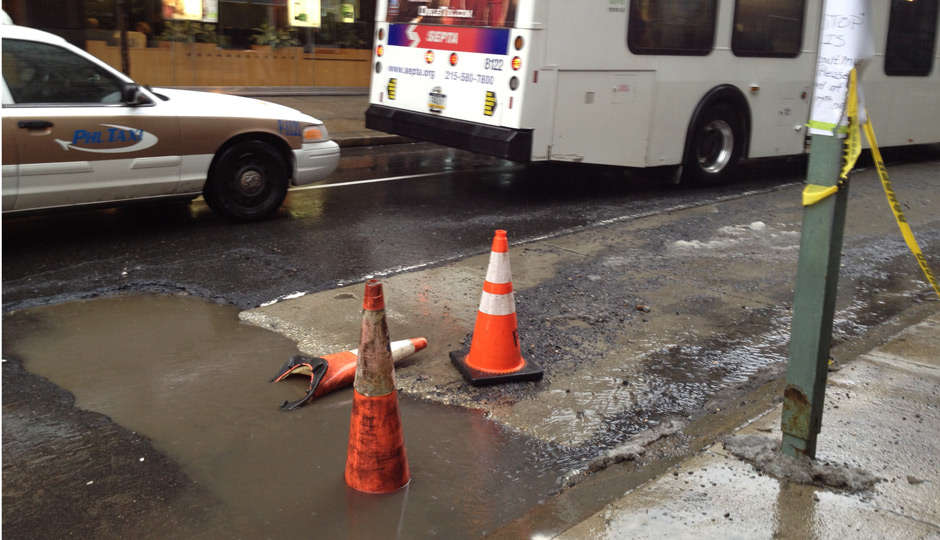Welcome to Pothole Hell, Philadelphia
Now that this brutal winter has had its way with us — and I’m just going to pretend that there’s not an entire month of it still on the calendar —we’re left to deal with the terror and destruction left in its wake: potholes. And they are everywhere.
On Monday afternoon, I ventured out to City Avenue and did a little bit of counting. Heading north on City Avenue, from 76th Street to City Avenue’s intersection with Belmont Avenue, I counted over 300 potholes. Yes, 300.
That stretch of road measures out to about three miles, meaning 100 holes per mile. And that’s only counting the northbound side of City Avenue. If we’re in pothole hell, then City Avenue must be the Ninth Circle.
Others have taken notice of Philadelphia’s ridiculous pothole problem:
NBC10 @ Issue Philadelphia? Even directly across the street from the NBC 10 station on city Avenue, there are at least six deep potholes.
— Soleiman Raie (@TopGun0917) February 19, 2014
Dear City of Philadelphia these potholes/ craters are costing me more to get my car fixed than I planned. Thank you said no one ever
— Jocelyn.Noelle (@JoceBrownSugar) February 18, 2014
.@NASA next time you guys are testing moon rovers, feel free to use the crater-like potholes in #philadelphia @PhiladelphiaGov
— Valentin (@vpanyushenko) February 13, 2014
These pot holes are drawlin…city of Philadelphia thank you for not doing anything about it
— CHOOKALOOK (@Jbrono93) February 19, 2014
Understandably, street crews have been concentrating on getting rid of all the snow and ice, and then patching holes here and there when they can. But now, says the city, they are ready to attack the bruised and battered streets of Philadelphia full force.
“Now that we have a brief reprieve from the back-to-back snowstorms, Streets Department Highway crews will return to repairing potholes,” says Philadelphia Streets Department spokesperson Keisha McCarty, explaining that those crews were scheduled to hit the streets on Wednesday.
“We have inspectors locating potholes throughout the City,” says McCarty. “In addition, we have a list of specific areas where we have received requests for pothole repairs. Our repair crews cluster the requests and inspection reports geographically and repair as needed. We will have pothole crews working throughout the city, weather permitting, all week and throughout the weekend.”
It turns out that City Avenue potholes are actually the domain of PennDOT, which also plans to start working on the pothole problem on Wednesday, says PennDOT spokesperson Gene Blaum. He adds that City Avenue is among the most severely affected arteries in the state.
“We’ve been on City Avenue since January,” says Blaum. “Normally, pothole season doesn’t start until around now and goes into mid-March. But this year, it started early in January.”
Blaum points to the weather in early January as the culprit: a January 2nd snowstorm followed by freezing rain immediately followed by warmer weather and then temperatures in the single digits. “With those extreme temperature changes and all that precipitation, we had pavements breaking everywhere. It was a shockwave. This is as severe a situation as we’ve experienced in quite some time.”
According to Blaum, PennDOT crews have been on City Avenue on 20 different occasions since the beginning of January. “But we can’t really fix it,” he says. “We get the holes filled, but it’s not long-lasting. We need hot asphalt to make the permanent fixes, and we’ll hopefully get that this week with the warmer temperatures. It’s a difficult situation.”
It sure is.
And there is plenty of work for the Streets Department, too. This giant hole has been causing traffic problems at 18th and Walnut streets for weeks:
The city points out that this is actually not a pothole. And no, it’s not a sinkhole, they say. It’s a “utility trench.”
The Streets Department explains:
The defect at 18th and Walnut is a utility trench, not a pothole. We have been making it safe until the weather permits a permanent restoration. The constant cycle of bad weather has caused it to unravel several times. We will again make it safe this weekend. The permanent restoration will be in the spring.
So what do you do if you see a pothole, sinkhole or other gaping abyss in the street? Well, what you don’t do is assume that somebody knows about it. That’s a good way to get nothing done.
If you see a pothole, report it. Note the exact location, approximate size, and whether the hole is in a traffic lane, and then contact 311 or the Streets Department’s customer service line at 215-686-5560. You can also fill out a pothole report via potholes.phila.gov. And if they don’t fix your pothole problem in a timely fashion, be sure to let me know.
Top Photo (Stock): David Shankbone. Bottom photo and additional reporting: Jack Cotter.



